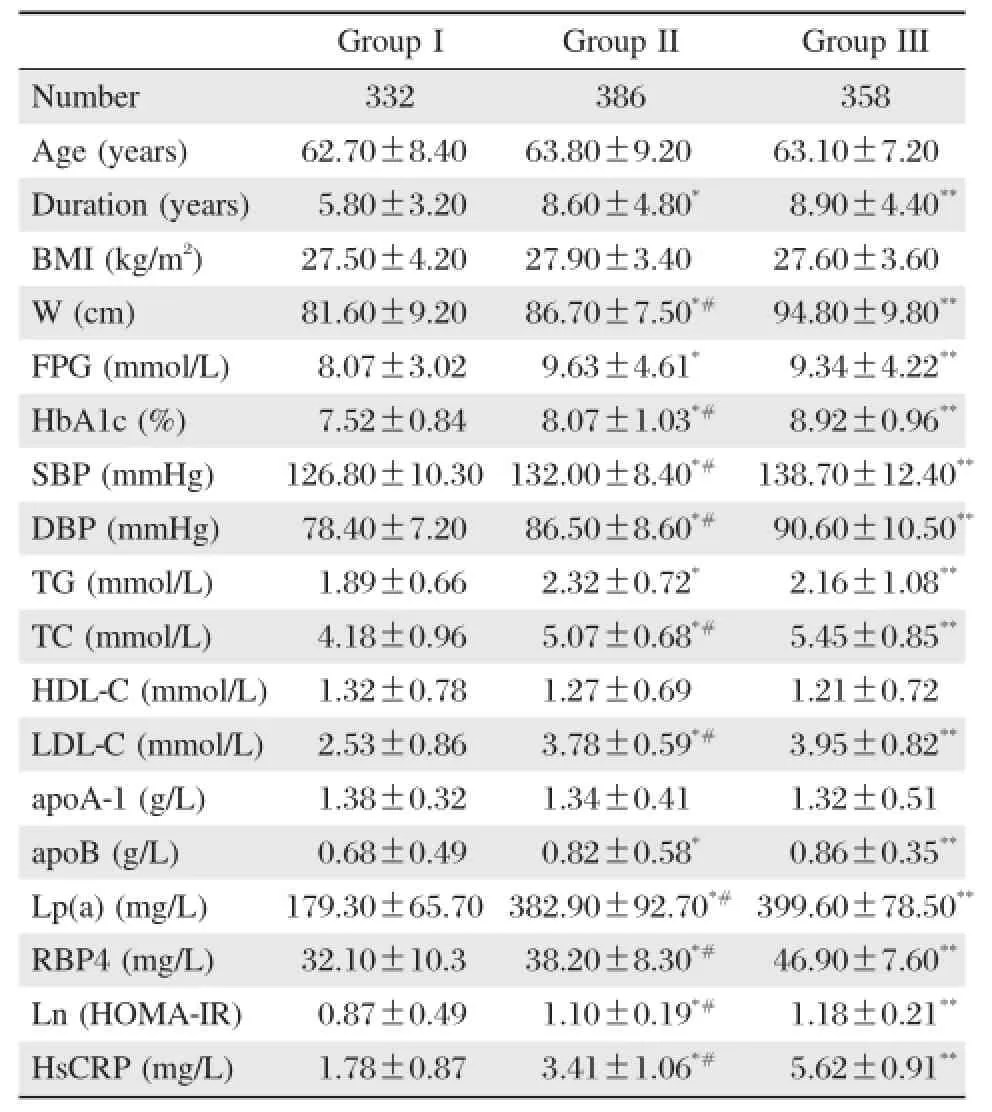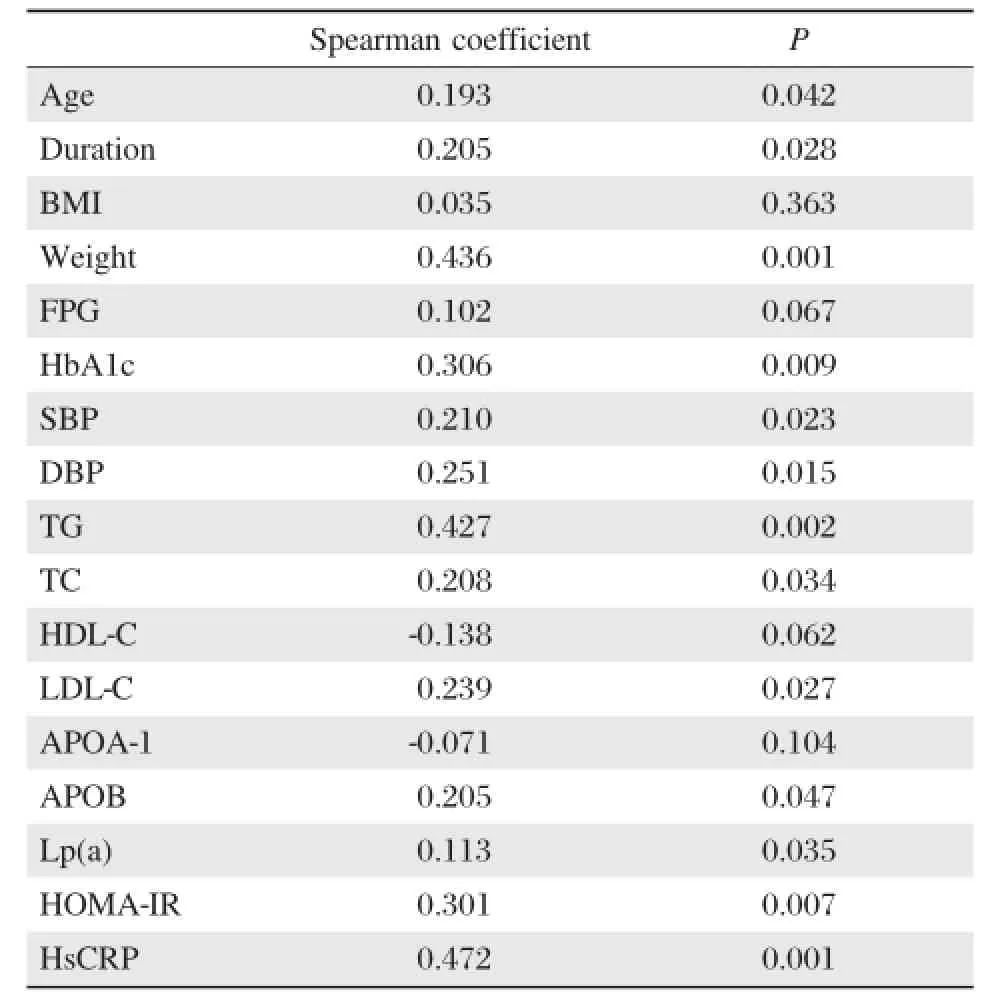Retinolbinding protein 4 correlates with and is an early predictor of carotid atherosclerosis in type 2 diabetes mellitus patients
Shangyong Feng,Yan Zhu,Caifeng Yan,Yan Wang,Zhenweng Zhang
Department of Endocrinology,the Affiliated Hospital of Yangzhou University,Yangzhou,Jiangsu 225001,China.
Retinolbinding protein 4 correlates with and is an early predictor of carotid atherosclerosis in type 2 diabetes mellitus patients
Shangyong Feng,Yan Zhu,Caifeng Yan,Yan Wang,Zhenweng Zhang✉
Department of Endocrinology,the Affiliated Hospital of Yangzhou University,Yangzhou,Jiangsu 225001,China.
The association of retinolbinding protein 4(RBP4)with atherosclerosis of the carotid artery in type 2 diabetes mellitus(T2DM)remains undefined.We aimed to investigate the correlation of RBP4 expression with atherosclerosis ofthe carotid artery in T2DM.A totalof1,076 subjects were investigated forintima-media thickness ofthe bilateral common carotid arteries,and they were divided into three groups:in group I,patientshad normalneck vascularultrasound,in group II,intimalcarotid artery media thickness was equalto ormore than 1 mm,and in group III,carotid artery plaque was present.Height,weight,blood pressure(BP),fasting plasma glucose(FPG),hemoglobin A1c (HbA1c),totalcholesterol(TC),triglyceride(TG),low-density lipoprotein cholesterol(LDL-C),high-density lipoprotein cholesterol(HDL-C),apolipoprotein A-1(apoA-1),apolipoprotein B(apoB)and lipoprotein(a)[Lp(a)]were determined by routine laboratory methods.RBP4 and high sensitivity C reactive protein(HsCRP)were measured by an enzyme-linked immuno-sorbentassay,and insulin concentration was measured by an electrochemiluminescence sandwich immunoassay.Duration of diabetes,waistand BP,FPG,HbA1c,TG,TC,LDL-C,APOB,Lp(a),HsCRP, RBP4 and homeostasis modelassessmentinsulin resistance index(HOMA-IR)were significantly lower in group I than in the other two groups(P<0.01,P<0.01).Plasma levels of HbA1c,RBP4,LDL-C,TC,HOMA-IR,HsCRP and Lp(a),waistand BP were significantly increased in group IIIthan in group II(P<0.01).Multivariate logistic regression analysis showed thatthere were seven factors associated with the occurrence ofcarotid artery atherosclerosis and itsrisks in descending orderwere:high LDL-C,high waist,high HsCRP,duration ofdiabetes,high HOMA-IR, HbA1c and high RBP4.Our finding supported that RBP4 was positively correlated with carotid atherosclerosis in patients with T2DM and could be used as an early predictor of cardiovascular disease.
type 2 diabetes mellitus,retinolbinding protein 4,subclinicalatherosclerosis
Introduction
Diabetes mellitus(DM)is a metabolic disorder that can be affected by genetic factors,environmentand life styles.The incidence of DM,especially type 2,is dramatically increasing due to the growing obesity and immobility in China[1-2].Epidemiologic surveys have recently reported a high incidence of atherosclerosis in patients with DMwhich isan artery damage attributing to cholesteroldeposition,immunesubstanceinfiltration,connective tissue hyperplasia and can cause severe ischemic heartdisease,cerebrovascular disease and death.Therefore,quantitative assessmentof atherosclerosis and its risks is very important.Carotid ultrasound for measurementof intima-media thickness(IMT)and detection of atheroma plaques is anon-invasive,well standardized and validated imaging technique that is currently recommended by clinical guidelines for cardiovascular risk assessment[3].RBP are a family of proteins with diverse functions.They are carrier proteins thatbind to retinol.RBP4 may play an importantrole in the origin of insulin resistance and metabolic syndrome[4-5].However,there is scanty data on the relationship between RBP4 and IMT and subclinicalatherosclerosisin type2 diabetesmellitus(T2DM).
Patients and methods
Patients
A totalof 1,076 inpatientpatients(578 men)with a mean age of 62.8±13.6(ranged from 35 to 82)years were admitted for this study atthe authors'affiliated hospital.All patients were diagnosed with T2DM. Type 1 DM and secondary DM were excluded.All patients provided informed consent and the study was approved by the local Institutional Review Board atthe authors'affiliated institution.
Carotid intima-media thickness assessment
IMT ofthe bilateralcommon carotid arterieswasmeasured using a GE Logiq7 lineararray probe(7.5 MHz). Patients were examined in the supine position with their head tilted back.Each common carotid artery wasevaluated with the subject'shead turned slightly to the contralateralside.The field depth,gain,and near-and far-field gain controls were optimized to enable visualization of thefarwallofthecommoncarotid artery.Allimageswere interpreted by a single technician,specifically trained in the assessmentof carotid intima-media thickness (CIMT).The patients were stratified into 3 groups:neck vascularultrasound showed no abnormalities(Group I), intimalthickening was defined as carotid artery media thickness≥1 mm(Group II),and carotid artery plaque was defined as a focalarea of arterialwallthickness≥1.5 mm(Group III).
Laboratory and clinical data
In all patients,fasting plasma glucose(FPG),baseline total cholesterol(TC),triglyceride(TG),lowdensity lipoprotein cholesterol(LDL-C),high-density lipoprotein cholesterol(HDL-C),apolipoprotein A-1 (apoA-1)and apolipoprotein B(apoB)were measured from fasting blood samples with the enzymatic colorimetric method by using commercial kits on a OLYMPUS AU2700(Japan).Glycosylated hemoglobin A1c(Hb A1c)was determined by high pressure liquid chromatography(HPLC,Bio-Rad,Hercules, CA,USA).RBP4 and high sensitivity C reactive protein(hsCRP)were measured by an enzyme-linked immuno-asorbentassay(ELISA,Phoenix,American). Insulin concentration(mIU/L)was measured from fasting blood samples using an electrochemiluminescence sandwich immunoassay(ECLIA,Roche Diagnostics,Mannheim,Germany)on a MODULAR ANALYTICS SWA Modular DDPP+EE.Homeostasis model assessment insulin resistance index (HOMA-IR)was defined as(fasting plasma glucose (mmol/L)×serum insulin(mIU/L))/22.5[6].
Statistical analysis
All statistical analyses were performed using SPSS (version 13.0;SPSS Inc,Chicago,IL,USA).The data were expressed as mean±SD,exceptfordata thatdid not have a normal distribution,which were expressed as median(interquartile range).Variables were tested for normality using Kolmogorov-Smirnov Z statistic. Between-group differences were analyzed with one-way ANOVA in conjunction with SNK-q test. Correlation relationships between plasma RBP4 concentrations and various metabolic parameters were analyzed with Spearman correlation analysis.Multivariate analysis was used with logistic regression analysis. RBP4,duration of DM,waist,HsCRP,HOMA-IR, LDL-C,Lp(a),DBP and HbA1c were independentvariables in the multivariable-adjusted models with carotid artery plaque as the dependent variable,including Group IIand Group III,and age and sex as the covariates.Two-tailed significance values were given with P<0.05 regarded as significant.
Results
Therewere 116 men(34.9%)and 216 women(65.1%) in Group I,192 men(49.7%)and 194 women(50.3%)in Group II,201 men(56.1%)and 157 women(43.9%)in Group III.The mean age,BMI,HDL-C and apoA-1 were notdifferentamong the three groups.Duration of diabetes,waist,BP and the serum levels of FPG,HbA1c, TG,TC,LDL-C,apo B,Lp(a),HsCRP,RBP4 and HOMA-IR were significantly lower in normalcontrols than in the othertwo groups(P<0.01).Although duration ofdiabetes,FPG,apoB and TG showed no significantdifference between Group IIand Group III,waist, BP and plasma levels of HbA1c,Lp(a),RBP4,LDL-C, TC,HOMA-IR and HsCRP were significantly higher in patients with carotid artery plaque than in intimal thickening(P<0.01)(Table 1).
Spearman correlation showed that RBP4 concentrations were weakly correlated with duration ofdiabetes, BP,TC,LDL-C,apoB and Lp(a),while no associations were found between RBP4 and age,BMI,FPG, HDL-C and apo A-1;waist circumference,Hb A1c,HOMA-IR,TG and HsCRP demonstrated moderate correlation with RBP4 of allinvestigated cardiovascular risk factors(Table 2).

Table 1 Baseline characteristics of the study subjects
Table 3 summarizes the risk factors of carotid artery atherosclerosis by using multiple logistic regression analysis,which showed that there were seven factors associated with the occurrence of carotid artery atherosclerosis and its risk in descending order were: high LDL-C,high waist,high HsCRP,duration ofdiabetes,high HOMA-IR,HbA1c and high RBP4 while Lp(a)and BP showed no significant association with carotid artery atherosclerosis.
Discussion
The prevalence of diabetes is increasing throughout the world,which has a high incidence ofmacro-vascular complication.Macroangiopathy is a heterogeneous disorder characterized by multifactorialetiology and various processes,including changes in adipocytokines, activation of low-grade inflammation,and others. RBP4 was discovered as an adipocytokine thatbound specifically to vitamin A and produced mainly by the liver and adipose tissues.RBP4 levels were closely associated with obesity,particularly visceraladiposity in mice and humans[7-8].The main finding of our study was that RBP4 concentrations were associated with the prevalence ofcarotid artery atherosclerosis in 1,076 samples of T2DM,which suggested a participation of RBP4 in modulation ofatherosclerotic processand cardio-and cerebrovascular diseases.Our result is inconsistent with some previous studies which reported an inverse correlation between RBP4 levels and CIMT in postmenopausal women[9-10],which could attribute to differentstudy populations and designs.
Itis known thatelevated RBP4 levels are associated with a clustering of components of metabolic syndrome in insulin-resistant subjects.In population-based studies,RBP4 levels were positively associated with the obesity index,high blood pressure and unfavorable lipid profiles[11-12].Similar to our finding of higher RBP4 value with triglyceride level,previous studies have shown that RBP4 was correlated with serum triglycerides[13-15].In the elderly,RBP4 concentrations were associated with metabolic syndrome and its components in both sexes and prior cerebrovascular disease in men.These findings are consistent with th e hypothesis that circulating RBP4 could be a marker of metabolic complications and possibly alsoatherosclerosis and overt CVD[16].Our study showed that plasma RBP4 levels were significantly higher in patients with carotid artery plaque,and plasma RBP4 levelsshowed significantcorrelation with cardiovascular risks in T2DM patients.Some studies reported that RBP4 levels could play an importantrole in lipid metabolism in morbid obesity,increasing triglyceride levels and contributing to the formation ofsmall HDL[17-18].In animalmodels,the overexpression ofhuman RBP4 or the injection of recombinant RBP4 induced insulin resistance in mice,whereas RBP4 knockout mice showed enhanced insulin sensitivity.Since evidence showing relationship of RBP4 with cardiometabolic risk in humansis inconsistent,there isstillan argument on whether elevated RBP4 levels contribute to the pathogenesis ofabnormalglucose homeostasis orinsulin resistance.RBP4 can down-regulate glucose transporter4(GLUT4)selectively in adipocytes and the insulin-activated glucose transporter is responsible for translocation ofglucose into both muscle and fatcells. Studies reported that the serum level of RBP4 was highly negatively correlated with obesity or insulin sensitivity[19-21].However,Janke etal.reported discrepancy ofrelationship of RBP4 with glucose homeostasis and insulin resistance between rodents and humans. Our results suggested a direct relationship between circulating insulin and RBP4 levels,which indicated that this protein might contribute to the development of muscle insulin resistance[22-23].A retrospective cohort study provided evidence that RBP4 may be a mechanism through which obesity influenced insulin resistance and h ypertriglyce ridemia in overwe ight postpubertal black youth and suggested utility of RBP4 as a biomarker of risk[24].In mice,overexpression of RBP4 has been shown to cause insulin resistance presumably by enhanced expression of the gluconeogenic enzyme phosphoenolpyruvate carboxykinase and impairment of muscle insulin action[18]. More data are needed to clarify the potential role of RBP4 in abnormal metabolic consequences.

Table 2 Correlation between plasma RBP4 concentrations and various metabolic parameters

Table 3 Logistic regression analysis of carotid atherosclerosis risk factors
Balagopal et al.reported that RBP4 was positively associated with hsCRP in a smallgroup of obese children[25].However,Liu Y et al.showed that plasma RBP4 levels were associated with an adverse profile of oxidative stress and inflammatory markers in a middle-aged and elderly Chinese population and the association was independentof conventional risk factors[26].Itis wellknown thatthe risk of atherosclerosis is much higherin diabetic patients and the endogenous defense of the vascular endothelium begins to break down in response to diabetes.However,previous studies on whether RBP4 was involved in insulin-induced proliferation of vascular smooth muscle cells and inflammation leading to atherosclerosis in humans have shown conflicting findings[5].In this study,correlation analysis showed that the plasma HsCRP level was significantly correlated with carotid atherosclerosis,which is consistentwith the hypothesis thatcirculating HsCRP could be used as early biochemical markers of cardiovascular diseases.
This study has some limitations.Firstly,the crosssectional nature of the study design cannotbe translated into a clear cause-effect inference.Prospective studies and randomized clinical trials are needed. Secondly,the key threatto any observationalstudy is bias of unmeasured or residualconfounding that cannot be ruled out;however,the multivariate models adjusted fora wide range ofrisk factors thathave been implicated in the developmentof cardiovascular diseases in patients with T2DM.Thirdly,the study did notconsider the impact of smoking and drinking on RBP4,in addition,only inpatient patients took part in the study and duration of diabetes was more than five years.These factors may contribute to some bias.
In summary,in patients with type 2 diabetes,serum RBP4 is positively correlated with carotid atherosclerosis, and may cause carotid artery atherosclerosis through the influence of insulin sensitivity,lipid metabolism,and the body oxygen oxidative stress.RBP4 can be used as an early predictor of cardiovascular disease risk factor in T2DM patients.Compared to vascular ultrasound,RBP4 detection is more convenient and inexpensive,and could be defined as a routine testitem to help early detection and intervention of vascular complications.
Acknowledgements
We would like to thank the patients who volunteered for thisstudy and thestaffofDepartmentofEndocrinology in the Affiliated Hospitalof Yangzhou University.
[1]Xu Y,Wang L,He J,et al.Prevalence and controlof diabetes in Chinese adults[J].JAMA,2013,310(9):948-959.
[2]Yang W,Lu J,Weng J,et al.Prevalence of diabetes among men and women in China[J].N Engl J Med, 2010,362(12):1090-1101.
[3]Lorenz MW,von Kegler S,Steinmetz H,et al.Carotid intima-media thickening indicates a higher vascular risk across a wide age range:prospective data from the Carotid Atherosclerosis Progression Study(CAPS)[J]. Stroke,2006,37(1):87-92.
[4]Raila J,Henze A,Spranger J,etal.Microalbuminuria is a majordeterminantofelevated plasma retinol-binding protein 4 in type 2 diabetic patients[J].Kidney In,2007,72(4): 505-511.
[5]Li F,Xia K,Sheikh MS,et al.Retinolbinding protein 4 promotes hyperinsulinisminduced proliferation of rat aortic smooth muscle cells[J].Mol Med Rep,2014,9(5): 1634-1640.
[6]Matthews DR,Hosker JP,RudenskiAS,etal.Homeostasis modelassessment:insulin resistance and beta-cellfunction from fasting plasma glucose and insulin concentrations in man[J].Diabetologia,1985,28(7):412-419.
[7]Wolf G.Serum retinol-binding protein:a link between obesity,insulin resistance,and type 2 diabetes[J].Nutr Rev,2007,65(5):251-256.
[8]Janke J,Engeli S,Boschmann M,et al.Retinol-binding protein 4 in human obesity[J].Diabetes,2006,55(10):2805-2810.
[9]Calo LA,Maiolino G,Pagnin E,etal.Increased RBP4 in a human model of activated anti-atherosclerotic and antiremodelingdefences[J]Eur J ClinInvest,2014,44(6): 567-572.
[10]Huang G,Wang D,Khan UI,et al.Associations between retinol-binding protein 4 and cardiometabolic risk factors and subclinicalatherosclerosis in recently postmenopausal women:Cross-sectional analyses from the KEEPS Study[J].CardiovascDiabetol,2012,11:52.
[11]Qi Q,Yu Z,Ye X,etal.Elevated retinol-binding protein 4 levels are associated with metabolic syndrome in Chinese people[J].J ClinEndocrinolMetab,2007,92(12):4827-4834.
[12]Verges B,Guiu B,Cercueil JP,et al.Retinol-binding protein 4 is an independent factor associated with triglycerides and a determinant of very low-density lipoprotein-apolipoprotein B100 catabolism in type 2 diabetes mellitus.ArteriosclerThromb Vasc Biol,2012, 32(12):3050-3057.
[13]Takebayashi K,Suetsugu M,Wakabayashi S,et al. Retinol binding protein-4 levels and clinical features of type 2 diabetes patients[J].J Clin Endocrinol Metab, 2007,92(7):2712-2719.
[14]Kashyap SR,Diab DL,Baker AR,et al.Triglyceride levels and notadipokine concentrations are closely related to severity of nonalcoholic fatty liver disease in an obesity surgery cohort[J].Obesity(Silver Spring),2009,17(9): 1696-1701.
[15]Lin CC,Lai MM,Li TC,et al.Relationship between serum retinol-binding protein 4 and visfatin and the metabolic syndrome[J].Diabetes Res Clin Pract,2009, 85(1):24-29.
[16]Mostafaie N,Sebesta C,Zehetmayer S,et al.Circulating retinol-binding protein 4 and metabolic syndrome in the elderly[J].Wien Med Wochenschr,2011,161(21-22):505-510.
[17]Rocha M,Banuls C,Bellod L,etal.Association of serum retinolbinding protein 4 with atherogenic dyslipidemia in morbid obese patients[J].PLoS One,2013,8(11):e78670.
[18]Yang Q,Graham TE,Mody N,et al.Serum retinol binding protein 4 contributes to insulin resistance in obesity and type 2 diabetes[J].Nature,2005,436(7049):356-362.
[19]Park H,Green MH,Shaffer ML.Association between serum retinol-binding protein 4 concentrations and clinical indices in sub jects with type 2 diabetes:a metaanalysis[J].J Hum Nutr Diet,2012,25(4):300-310.
[20]Moraes-Vieira PM,Yore MM,Dwyer PM,et al.RBP4 activates antigen-presenting cells,leading to adipose tissue inflammation and systemic insulin resistance[J].Cell Metab,2014,19(3):512-526.
[21]Norseen J,Hosooka T,Hammarstedt A,et al.Retinolbinding protein 4 inhibits insulin signaling in adipocytes by inducing proinflammatory cytokines in macrophages through a c-Jun N-terminal kinase-and toll-like receptor 4-dependent and retinol-independent mechanism[J].Mol Cell Biol,2012,32(10):2010-2019.
[22]Graham TE,Yang Q,Bluher M,et al.Retinol-binding protein 4 and insulin resistance in lean,obese,and diabetic subjects[J].N Engl J Med,2006,354(24):2552-2563.
[23]Yeste D,Vendrell J,Tomasini R,etal.Retinol-binding protein 4 levels in obese children and adolescents with glucose intolerance[J].Horm Res Paediatr,2010,73(5):335-340.
[24]Goodman E,Graham TE,Dolan LM,et al.The relationship of retinol binding protein 4 to changes in insulin resistance and cardiometabolic risk in overweight black adolescents[J].J Pediatr,2009,154(1):67-73.e1.
[25]Balagopal P,Graham TE,Kahn BB,et al.Reduction of elevated serum retinol binding protein in obese children by lifestyle intervention:association with subclinical inflammation[J].J ClinEndocrinol Metab,2007,92(5): 1971-1974.
[26]Liu Y,Wang D,Li D,et al.Associations of retinol-binding protein 4 with oxidative stress,inflammatory markers, and metabolic syndrome in a middle-aged and elderly Chinese population[J].DiabetolMetab Syndr,2014, 6(1):25.
✉Corresponding author:Dr.Zhenweng Zhang,Department of Endocrinology,the Affiliated Hospital of Yangzhou University,98 Nantong West Road,Yangzhou,Jiangsu 225001,China.Tel/Fax: +86-514-87373195/+86-514-87373190,E-mail:yzzzw@medmail.com.cn.
Received 25 June 2014,Revised 01 October 2014,Accepted 01 April 2015,Epub 03 July 2015
R587.1,Document code:A
The authors reported no conflict of interests.
©2015 by the Journal of Biomedical Research.All rights reserved.
10.7555/JBR.29.20140087
 THE JOURNAL OF BIOMEDICAL RESEARCH2015年6期
THE JOURNAL OF BIOMEDICAL RESEARCH2015年6期
- THE JOURNAL OF BIOMEDICAL RESEARCH的其它文章
- Platelets in hemostasis and thrombosis:Novelmechanisms of fibrinogen-independent platelet aggregation and fibronectinmediated protein wave of hemostasis
- CC-chemokine receptor 7 and its ligand CCL19 promote mitralvalve interstitialcellmigration and repair
- Effectofburden and origin sites ofpremature ventricular contractions on left ventricular function by 7-day Holter monitor
- Prevention ofatrialfibrillation with renin-angiotensin system inhibitors on essentialhypertensive patients:a meta-analysis of randomized controlled trials
- Epirubicin-gold nanoparticles suppress hepatocellular carcinoma xenograft growth in nude mice
- A susceptibility locus rs7099208 is associated with non-obstructive azoospermia via reduction in the expression of FAM160B1
